Smart Sustainable Freight Transport for a City Multi-Floor Manufacturing Cluster: A Framework of the Energy Efficiency Monitoring of Electric Vehicle Fleet Charging
Abstract
:1. Introduction
2. Literature Review
2.1. EMS and Its Role in Energy Consumption Management for Sustainable Development
2.2. The Role of Energy Efficiency Monitoring in SEMS
2.3. Principles of SEMS
3. Materials and Methods
3.1. SEMS for Independent Fleet of Freight EVs within the CMFMC
- Technical group—involves an analysis of the state of the independent fleet of freight EVs, their characteristics, and a comparative analysis of the efficiency of using different EVs for cargo transportation.
- Logistics group—involves considering requests for volumes, destinations, and time of cargo delivery, planning and optimizing the route of cargo delivery, and the freight EVs movement considering urban traffic.
- Energy group—involves planning the electricity consumption by the EVs for cargo transportation, the amount of electricity consumption by the independent fleet, the charging mode of freight EVs, and the creation of a charging profile (charging scenarios considering technical limitations, including the power system) as well as assessing the residual charge of the EV battery and the possibility of electricity supply to the electrical grid during hours of maximum electrical load. In the case of a CS power supply from a local electrical grid with sources of distributed generation (wind or solar power plants), the issue of planning the amount of electricity generation from these sources and charging EVs to use them as electricity storage devices for the electrical grid then becomes relevant.
- Economic group—involves assessing the efficiency of cargo transportation, considering the costs of their implementation, including electricity costs, assessment of the charging mode efficiency of freight EVs, and considering electricity prices at different hours of the day.
3.2. Information Support for Integrated Monitoring
3.3. Object-Oriented Formalization of Information Technology for Integrated Energy Efficiency Monitoring of the Independent Fleet of Freight EVs within the CMFMC
- WEB-service—a set of classes integrated by the procedure for obtaining initial information about the object of study (technical characteristics of the independent fleet of freight EVs: load capacity, battery power, power reserve, etc.; characteristics of cargo transportation: volume, time, route of cargo delivery, speed of movement, etc.; climatic factors; CS operating mode indicators; electrical grid indicators: electrical load, power reserve, electricity tariffs, power consumption, etc.).
- FORMS-class is a set of classes associated with computational algorithms and models, providing the following procedures:
- -
- “Cargo delivery” class—provides for sub-class “Delivery route” (description, analysis, and optimization of the route of cargo delivery, detection and identification of cyclical changes in demand for cargo transportation); sub-class “Electric vehicle operation mode” (formalized description of cargo transportation for typical operating conditions; adjustment of the cargo transportation characteristics and its route, taking into account cyclical changes in demand; planning energy-efficient modes of operation for the independent fleet of freight EVs within the CMFMC).
- -
- “Electric power consumption” class—provides for sub-class “Electric power consumption of freight EV” (power consumption models for EVs of different types taking into account climatic factors; determination of the basic level of electric consumption for EVs of different types); sub-class “Electric power consumption of the independent fleet of freight EVs within the CMFMC” (power consumption models considering cyclical changes in demand; determination of the basic level of power consumption for typical work conditions).
- -
- “Operation with electrical grid” class—provides for: sub-class “EV charging” (formation of the freight EV charging profile considering the characteristics of the battery and its operating schedule); sub-class “Charging mode of the independent fleet of freight EVs within the CMFMC” (planning of the charging schedule of freight EVs considering their operation schedules, formation of the charging profile of the the independent fleet of freight EVs within the CMFMC); sub-class “Electric grid load” (optimization of electric power consumption of the freight EVs connected to CS; CS load profile planning); sub-class “Discharge mode of the independent fleet of freight EVs within the CMFMC” (determination of the amount of electricity to be generated by EVs into the electric grid, considering the remaining battery charge, planning the schedule of the independent fleet of freight EVs to the electric grid, and considering their operation schedules); sub-class “Generation of electricity from renewable energy sources” (determination of the volume of electricity generation from renewable energy sources considering climatic factors, formation of a profile of electricity generation from renewable energy sources, and formation of a CS load profile on the electric grid considering the profile of electricity generation from renewable energy sources).
- -
- “Energy efficiency indicators” class—provides for sub-class “Energy efficiency indicators of the independent fleet of freight EVs” (determination of the energy efficiency coefficients of the independent fleet of freight EVs within the CMFMC participating in cargo transportation, and the coefficient that considers the level of EV battery degradation); sub-class “Indicators of energy efficiency of cargo transportation” (determination of coefficients of energy efficiency of cargo transportation within the CMFMC); sub-class “CS energy efficiency indicators” (determination of the energy efficiency coefficients of CS operating modes within the CMFMC).
- -
- “Energy efficiency benchmarking” class—provides for sub-class “Energy efficiency of freight EVs” (comparative analysis (internal and external) and assessment of the level of energy efficiency of the independent fleet of freight EVs within the CMFMC participating in cargo transportation; setting tasks for its improvement); sub-class “Energy efficiency of cargo transportation” (comparative analysis (internal and external) and assessment of the level of energy efficiency of cargo transportation within the CMFMC; establishment tasks for improvement).
- The control class is a set of classes associated with procedures for monitoring the energy-efficient operation of the independent fleet of freight EVs. Provides the following procedures:
- -
- “Operational control” class—provides for sub-class “Control of electrical consumption” (control of the efficiency of electrical consumption of freight EVs, considering their operation schedule and the independent fleet of freight EVs within the CMFMC, identification of moments of non-accidental reduction (increase) in the efficiency of electrical consumption, and signaling the exceeding of planned values for independent fleet electrical consumption); sub-class “Control of cargo transportation” (control of characteristics of cargo transportation and identification of reasons for non-compliance with planned values power consumption); sub-class “Control of energy efficiency indicators” (control of operation energy efficiency indicators of the independent fleet of freight EVs and the dynamics of specific power consumption to identify trends in increasing/decreasing the level of energy efficiency); sub-class “Control of electrical grid operation” (control of the CS electrical load profile).
- -
- “Benchmarking control” class– provides for sub-class “Control of energy efficiency indicators” (analysis of the dynamics of the energy efficiency level of the independent fleet of freight EVs within the CMFMC, analysis of the dynamics of energy efficiency indicators of freight EVs); sub-class “Control of cargo transportation” (analysis of the dynamics of energy efficiency indicators of cargo transportation).
3.4. Monitoring of CS Operation Mode and Its Impact on the Load of the Electrical Grid
4. Results
4.1. Analysis of Experimental Data
4.2. Development of the CS Mode Optimization Model
4.3. Evaluation of the Effectiveness of the Optimization Model of Intelligent Control of EV Charging and Simulation Results
5. Discussion and Conclusions
Author Contributions
Funding
Institutional Review Board Statement
Informed Consent Statement
Data Availability Statement
Conflicts of Interest
Nomenclature
| CWI | Charge weight index |
| Pdc | Charge power on the battery side (kW) |
| Pac | Charge power on the electrical grid side (kW) |
| SOC | Battery charge level (%) |
| SOCreg | Required value of the battery charge level of the EV (%) |
| SOCstrart | Initial value of the battery charge level of the EV (%) |
| VOCeq | Voltage of the controlled equivalent voltage source (V) |
| Vc | Voltage of the electrical grid (V) |
| Vpack | Voltage on the battery side (at the battery terminals) during charging (V) |
| ic | Current of the electrical grid during charging (A) |
| i | Current on the battery side during charging (A) |
| Qbat | Battery capacity (Ah) |
| Wreq | Energy needed to charge the EV (kWh) |
| tparking | Charging time (parking time) of the EV (h) |
| μ | Membership function |
| η | Energy conversion efficiency of the charger |
| Req | Equivalent resistance (Ohm) |
| T | Sampling time step (min) |
| j | Profile step (period) number during charging |
| dQ(j) | Battery capacity change in step j (Ah) |
| Nc | Number of steps (periods) of the charging profile |
| Nd | Number of steps (periods) of discretization during twenty-four hours |
| N | Number of CS slots (pcs.) |
| Ps | Power of the CS on the electrical grid side (kW) |
| C | Electricity tariff (p.u./kWh) |
| Ps max | Power limits for a moment in time t (kW) |
| PL | Household power load (kW) |
| k | Number of the charging start period |
| l | Number of the current time period |
| f(tk) | Probability of starting the charging process on the k-th period |
| F(Pj,t1) | Probability of charging power consumption in the l-th period at the beginning of charging in the k-th period |
| h(SOCj) | Probability of the battery SOC the j-th period, considering the charging start period |
| x(t) | Percentage of freight EVs that received the stated charging level (%) |
| DCS,t | Decision to charge (1) or not (0) for the charging slot for time t |
| CS | Number of the charging slot |
References
- Dzhuguryan, T.; Jóźwiak, Z.; Deja, A.; Semenova, A. Infrastructure and Functions of a City Logistics Node for Multi-Floor Manufacturing Cluster. In Proceedings of the 8th International Scientific Conference CMDTUR, Žilina, Slovakia, 4–5 October 2018; pp. 196–201. [Google Scholar] [CrossRef]
- Deja, A.; Dzhuguryan, T.; Dzhuguryan, L.; Konradi, O.; Ulewicz, R. Smart sustainable city manufacturing and logistics: A framework for city logistics node 4.0 operations. Energies 2021, 14, 8380. [Google Scholar] [CrossRef]
- Dudek, T.; Dzhuguryan, T.; Wiśnicki, B.; Pędziwiatr, K. Smart Sustainable Production and Distribution Network Model for City Multi-Floor Manufacturing Clusters. Energies 2022, 15, 488. [Google Scholar] [CrossRef]
- Oubahman, L.; Duleba, S. Review of PROMETHEE method in transportation. Prod. Eng. Arch. 2021, 27, 69–74. [Google Scholar] [CrossRef]
- Dzhuguryan, T.; Wiśnicki, B.; Dudek, T. Concept of Intelligent Reconfigurable Trolleys for City Multi-Floor Manufacturing and Logistics System. In Proceedings of the 8th Carpathian Logistics Congress (CLC2018), Prague, Czech Republic, 3–5 December 2018; pp. 254–259. [Google Scholar]
- Wiśnicki, B.; Dzhuguryan, T. Integrated sustainable freight transport system for city multi-floor manufacturing clusters. Multidiscip. Asp. Prod. Eng. 2019, 2, 151–160. [Google Scholar] [CrossRef] [Green Version]
- Dzhuguryan, T.; Deja, A.; Wiśnicki, B.; Jóźwiak, Z. The Design of Sustainable City Multi-Floor Manufacturing Processes under Uncertainty in Supply Chains. Sustainability 2020, 12, 9439. [Google Scholar] [CrossRef]
- Iwan, S.; Nürnberg, M.; Jedliński, M.; Kijewska, K. Efficiency of Light Electric Vehicles in Last Mile Deliveries—Szczecin Case Study. Sustain. Cities Soc. 2021, 74, 103167. [Google Scholar] [CrossRef]
- Lin, Y.; Chen, A.; Yin, Y.; Li, Q.; Zhu, Q.; Luo, J. A framework for sustainable management of the platform service supply chain: An empirical study of the logistics sector in China. Int. J. Prod. Econ. 2021, 235, 108112. [Google Scholar] [CrossRef]
- Kijewska, K.; de Oliveira, L.K.; dos Santos, O.R.; Bertoncini, B.V.; Iwan, S.; Eidhammer, O. Proposing a Tool for Assessing the Level of Maturity for the Engagement of Urban Freight Transport Stakeholders: A Comparison between Brazil, Norway, and Poland. Sustain. Cities Soc. 2021, 72, 103047. [Google Scholar] [CrossRef]
- Ewbank, H.; Vidal Vieira, J.G.; Fransoo, J.; Ferreira, M.A. The Impact of Urban Freight Transport and Mobility on Transport Externalities in the SPMR. Transp. Res. Procedia 2020, 46, 101–108. [Google Scholar] [CrossRef]
- Britel, Z.; Cherkaoui, A. Development of a readiness for change maturity model: An energy management system implementation case study. Prod. Eng. Arch. 2022, 28, 93–109. [Google Scholar] [CrossRef]
- Morozova, I.A.; Yatsechko, S.S. The Risks of Smart Cities and the Perspectives of Their Management Based on Corporate Social Responsibility in the Interests of Sustainable Development. Risks 2022, 10, 34. [Google Scholar] [CrossRef]
- Lakatos, E.-S.; Nan, L.-M.; Bacali, L.; Ciobanu, G.; Ciobanu, A.-M.; Cioca, L.-I. Consumer Satisfaction towards Green Products: Empirical Insights from Romania. Sustainability 2021, 13, 10982. [Google Scholar] [CrossRef]
- Meidute-Kavaliauskiene, I.; Sütütemiz, N.; Yıldırım, F.; Ghorbani, S.; Činčikaitė, R. Optimizing Multi Cross-Docking Systems with a Multi-Objective Green Location Routing Problem Considering Carbon Emission and Energy Consumption. Energies 2022, 15, 1530. [Google Scholar] [CrossRef]
- Ližbetinová, L.; Štarchoň, P.; Weberová, D.; Nedeliaková, E.; Juříková, M. The Approach of SMEs to Using the Customer Databases and CRM: Empirical Study in the Slovak Republic. Sustainability 2020, 12, 227. [Google Scholar] [CrossRef] [Green Version]
- Directive 2012/27/EU of the European Parliament and of the Council of 25 October 2012 on Energy Efficiency, Amending Directives 2009/125/EC and 2010/30/EU and Repealing Directives 2004/8/EC and 2006/32/EC Text with EEA Relevance. Off. J. Eur. Union 2012, 315, 1–56. Available online: https://eur-lex.europa.eu/legal-content/EN/TXT/?uri=CELEX%3A32012L0027&qid=1648304389694 (accessed on 17 May 2022).
- Directive (EU) 2018/844 of the European Parliament and of the Council of 30 May 2018 Amending Directive 2010/31/EU on the Energy Performance of Buildings and Directive 2012/27/EU on Energy Efficiency (Text with EEA Relevance). PE/4/2018/REV/1. Off. J. Eur. Union 2018, 156, 75–91. Available online: https://eur-lex.europa.eu/legal-content/EN/TXT/?uri=CELEX%3A32018L0844&qid=1628935298304 (accessed on 17 May 2022).
- Council Decision (EU) 2016/590 of 11 April 2016 on the Signing, on Behalf of the European Union, of the Paris Agreement Adopted under the United Nations Framework Convention on Climate Change. Off. J. Eur. Union 2016, 103, 1–2. Available online: https://eur-lex.europa.eu/legal-content/EN/TXT/?uri=CELEX%3A32016D0590&qid=1648304505396 (accessed on 17 May 2022).
- Ulewicz, R.; Siwiec, D.; Pacana, A.; Tutak, M.; Brodny, J. Multi-Criteria Method for the Selection of Renewable Energy Sources in the Polish Industrial Sector. Energies 2021, 14, 2386. [Google Scholar] [CrossRef]
- Idzikowski, A.; Cierlicki, T. Economy and energy analysis in the operation of renewable energy installations—A case study. Prod. Eng. Arch. 2021, 27, 90–99. [Google Scholar]
- Directive (EU) 2019/944 of the European Parliament and of the Council of 5 June 2019 on Common Rules for the Internal Market for Electricity and Amending Directive 2012/27/EU (Text with EEA Relevance.). Off. J. Eur. Union 2019, 158, 125–199. Available online: http://data.europa.eu/eli/dir/2019/944/oj (accessed on 17 May 2022).
- Directive (EU) 2018/2002 of the European Parliament and of the Council of 11 December 2018 Amending Directive 2012/27/EU on Energy Efficiency (Text with EEA Relevance.) PE/54/2018/REV/1. Off. J. Eur. Union 2018, 328, 210–230. Available online: https://eur-lex.europa.eu/legal-content/EN/TXT/?uri=celex%3A32018L2002 (accessed on 17 May 2022).
- Pietrzak, O.; Pietrzak, K. The Economic Effects of Electromobility in Sustainable Urban Public Transport. Energies 2021, 14, 878. [Google Scholar] [CrossRef]
- Carli, R.; Dotoli, M. A Distributed Control Algorithm for Optimal Charging of Electric Vehicle Fleets with Congestion Management. IFAC-PapersOnLine 2018, 51, 373–378. [Google Scholar] [CrossRef]
- Hoke, A.; Brissette, A.; Smith, K.; Pratt, A.; Maksimovic, D. Accounting for Lithium-Ion Battery Degradation in Electric Vehicle Charging Optimization. IEEE J. Emerg. Sel. Top. Power Electron. 2014, 2, 691–700. [Google Scholar] [CrossRef]
- Scarabaggio, P.; Carli, R.; Cavone, G.; Dotoli, M. Smart Control Strategies for Primary Frequency Regulation through Electric Vehicles: A Battery Degradation Perspective. Energies 2020, 13, 4586. [Google Scholar] [CrossRef]
- Yan, G.; Liu, D.; Li, J.; Mu, G. A cost accounting method of the Li-ion battery energy storage system for frequency regulation considering the effect of life degradation. Prot. Control. Mod. Power Syst. 2018, 3, 4. [Google Scholar] [CrossRef]
- ISO 50001:2018(E); Energy Management Systems—Requirement with Guidance for Use. 2nd ed. ISO: Geneva, Switzerland, 2018; 30p.
- Danalakshmi, D.; Prathiba, S.; Ettappan, M.; Mohan Krishna, D. Reparation of voltage disturbance using PR controller-based DVR in Modern power systems. Prod. Eng. Arch. 2021, 27, 16–29. [Google Scholar] [CrossRef]
- European Commission (2009) Integrated Pollution Prevention and Control (IPPC). Reference Document on Best Available Techniques for Energy Efficiency. Seville: Institute for Prospective Technological Studies, European IPPC Bureau, 2008, 430p. Available online: https://ru.scribd.com/document/369464823/Reference-Document-on-Best-Available-Techniques-for-Energy-Efficiency-pdf (accessed on 17 May 2022).
- Herce, C.; Biele, E.; Martini, C.; Salvio, M.; Toro, C. Impact of Energy Monitoring and Management Systems on the Implementation and Planning of Energy Performance Improved Actions: An Empirical Analysis Based on Energy Audits in Italy. Energies 2021, 14, 4723. [Google Scholar] [CrossRef]
- Javied, T.; Rackow, T.; Franke, J. Implementing Energy Management System to Increase Energy Efficiency in Manufacturing Companies. Procedia CIRP 2015, 26, 156–161. [Google Scholar] [CrossRef] [Green Version]
- Valencia-Ochoa, G.; Rodriguez-Rodriguez, K.; Torregroza-Matos, G.; Acevedo-Penaloza, C.; Duarte-Forero, J. Implementation of the ISO 50001 standard to sustainable energy and economic saving the industrial sector. Sci. Tech. 2020, 25, 154–165. [Google Scholar] [CrossRef]
- Bonacina, F.; Corsini, A.; De Propris, L.; Marchegiani, A.; Mori, F. Industrial Energy Management Systems in Italy: State of the Art and Perspective. Energy Procedia 2015, 82, 562–569. [Google Scholar] [CrossRef] [Green Version]
- Poveda-Orjuela, P.P.; García-Díaz, J.C.; Pulido-Rojano, A.; Cañón-Zabala, G. ISO 50001: 2018 and Its Application in a Comprehensive Management System with an Energy-Performance Focus. Energies 2019, 12, 4700. [Google Scholar] [CrossRef] [Green Version]
- Introna, V.; Cesarotti, V.; Benedetti, M.; Biagiotti, S.; Rotunno, R. Energy Management Maturity Model: An organizational tool to foster the continuous reduction of energy consumption in companies. J. Clean. Prod. 2014, 83, 108–117. [Google Scholar] [CrossRef]
- McKane, A.; Therkelsen, P.; Scodel, A.; Rao, P.; Aghajanzadeh, A.; Hirzel, S.; Zhang, R.; Prem, R.; Fossa, A.; Lazarevska, A.M.; et al. Predicting the quantifiable impacts of ISO 50001 on climate change mitigation. Energy Policy 2017, 107, 278–288. [Google Scholar] [CrossRef]
- Silva Gonçalves, V.A.; Mil-Homens dos Santos, F.J. Energy management system ISO 50001:2011 and energy management for sustainable development. Energy Policy 2019, 133, 110868. [Google Scholar] [CrossRef]
- Chiu, T.-Y.; Lo, S.-L.; Tsai, Y.-Y. Establishing an Integration-Energy-Practice Model for Improving Energy Performance Indicators in ISO 50001 Energy Management Systems. Energies 2012, 5, 5324–5339. [Google Scholar] [CrossRef] [Green Version]
- Pelser, W.A.; Vosloo, J.C.; Mathews, M.J. Results and prospects of applying an ISO 50001 based reporting system on a cement plant. J. Clean. Prod. 2018, 198, 642–653. [Google Scholar] [CrossRef]
- Marimon, F.; Casadesús, M. Reasons to Adopt ISO 50001 Energy Management System. Sustainability 2017, 9, 1740. [Google Scholar] [CrossRef] [Green Version]
- Davydenko, N.; Korobiichuk, I.; Davydenko, L.; Nowicki, M.; Davydenko, V. Identification of cyclic changes in the operation mode of the production facility based on the monitoring data. Adv. Intell. Syst. Comput. 2020, 1044, 189–197. [Google Scholar] [CrossRef]
- Davydenko, L.; Rozen, V.; Davydenko, V.; Davydenko, N. Control of operation modes efficiency of complex technological facilities based on the energy efficiency monitoring. In Advances in Design, Simulation and Manufacturing II. DSMIE 2019. Lecture Notes in Mechanical Engineering; Springer: Cham, Switzerland, 2019; pp. 531–540. [Google Scholar] [CrossRef]
- Laayati, O.; Bouzi, M.; Chebak, A. Smart energy management: Energy consumption metering, monitoring and prediction for mining industry. In Proceedings of the 2020 IEEE 2nd International Conference on Electronics, Control, Optimization and Computer Science (ICECOCS), Kenitra, Morocco, 2–3 December 2020; pp. 1–5. [Google Scholar] [CrossRef]
- Pawar, P.; Kumar, M.T.; Vittal, K.P. An IoT based Intelligent Smart Energy Management System with accurate forecasting and load strategy for renewable generation. Measurement 2020, 152, 107187. [Google Scholar] [CrossRef]
- Saleem, M.U.; Usman, M.R.; Shakir, M. Design, Implementation, and Deployment of an IoT Based Smart Energy Management System. IEEE Access 2021, 9, 59649–59664. [Google Scholar] [CrossRef]
- Wang, Q.; Wang, H.; Zhu, L.; Wu, X.; Tang, Y. A Multi-Communication-Based Demand Response Implementation Structure and Control Strategy. Appl. Sci. 2019, 9, 3218. [Google Scholar] [CrossRef] [Green Version]
- Dongbaare, P.; Osuri, S.O.; Daniel Chowdhury, S.P. A smart energy management system for residential use. In Proceedings of the 2017 IEEE PES PowerAfrica, Accra, Ghana, 27–30 June 2017; pp. 612–616. [Google Scholar] [CrossRef]
- Rafique, M.K.; Khan, S.U.; Saeed Uz Zaman, M.; Mehmood, K.K.; Haider, Z.M.; Bukhari, S.B.A.; Kim, C.-H. An Intelligent Hybrid Energy Management System for a Smart House Considering Bidirectional Power Flow and Various EV Charging Techniques. Appl. Sci. 2019, 9, 1658. [Google Scholar] [CrossRef] [Green Version]
- Dzhuguryan, T.; Deja, A. Sustainable waste management for a city multifloor manufacturing cluster: A framework for designing a smart supply chain. Sustainability 2021, 13, 1540. [Google Scholar] [CrossRef]
- Pakanen, J.E.; Möttönen, V.J.; Hyytinen, M.J.; Ruonansuu, H.A.; Törmäkangas, K.K. A Web-Based Information System for Diagnosing, Servicing And Operating Heating Systems. J. Inf. Technol. Constr. 2001, 6, 45–56. [Google Scholar]
- Booch, G.; Maksimchuk, R.A.; Engel, M.W.; Young, B.J.; Conallen, J.; Houston, K.A. Object-Oriented Analysis and Design with Applications, 3rd ed.; Addison-Wesley Professional: Boston, MA, USA, 2007. [Google Scholar]
- Jewell, N.; Bai, L.; Naber, J.F.; Mcintyre, M.L. Analysis of electric vehicle charge scheduling and effects on electricity demand costs. Energy Syst. 2014, 5, 767–786. [Google Scholar] [CrossRef]
- Kong, P.-Y.; Karagiannidis, G.K. Charging Schemes for Plug-In Hybrid Electric Vehicles in Smart Grid. IEEE Access 2016, 4, 6846–6875. [Google Scholar] [CrossRef]
- Yandulskii, A.; Kurson, O.; Bosak, A.; Kondratiev, S.; Kuznietsov, A. Improvement of Electric Charging Station Efficiency using situation-dependent Fuzzy Algorithms. In Proceedings of the 2018 IEEE International Conference on Electrical Systems for Aircraft, Railway, Ship Propulsion and Road Vehicles & International Transportation Electrification Conference (ESARS-ITEC), Nottingham, UK, 7–9 November 2018; pp. 1–6. [Google Scholar] [CrossRef]
- Akhavan-Rezai, E.; Shaaban, M.F.; El-Saadany, E.F.; Karray, F. Online Intelligent Demand Management of Plug-In Electric Vehicles in Future Smart Parking Lots. IEEE Syst. J. 2016, 10, 483–494. [Google Scholar] [CrossRef]
- Marra, F.; Larsen, E. Electric Vehicles Integration in the Electric Power System with Intermittent Energy Sources—The Charge/Discharge Infrastructure; Technical University of Denmark (DTU): Kongens Lyngby, Denmark, 2013; 173p. [Google Scholar]
- Marra, F.; Yang, G.Y.; Larsen, E.; Rasmussen, C.N.; You, S. Demand profile study of battery electric vehicle under different charging options. In Proceedings of the 2012 IEEE Power and Energy Society General Meeting, San Diego, CA, USA, 22–26 July 2012; pp. 1–7. [Google Scholar] [CrossRef] [Green Version]
- Shen, W.; Thanh, T.V.; Kapoor, A. Charging Algorithms of Lithium-Ion Batteries: An Overview. In Proceedings of the 7th IEEE Conference on Industrial Electronics and Applications (ICIEA), Singapore, 18–20 July 2012; pp. 1567–1572. [Google Scholar] [CrossRef]
- Chen, M.; Rincon-Mora, G.A. Accurate Electrical Battery Model Capable of Predicting Runtime and I–V Performance. IEEE Trans. Energy Convers. 2006, 2, 504–511. [Google Scholar] [CrossRef]
- InnoPOWER. InnoPOWER-LFMP40AH Batteriezelle. Available online: https://www.innopower.de/produkte/innopower-lfmp40ah (accessed on 17 May 2022).
- Electricity Tariffs for Enterprises in Ukraine. 2017. Available online: https://maanimo.ua/helpful/tarifi-na-elektroenergiyu (accessed on 17 May 2022).
- Qian, K.; Zhou, C.; Allan, M.; Yuan, Y. Modeling of Load Demand Due to EV Battery Charging in Distribution Systems. IEEE Trans. Power Syst. 2011, 26, 802–810. [Google Scholar] [CrossRef]
- Zhang, P.; Qian, K.; Zhou, C.; Stewart, B.G.; Hepburn, D.M. A Methodology for Optimization of Power Systems Demand Due to Electric Vehicle Charging Load. IEEE Trans. Power Syst. 2012, 27, 1628–1636. [Google Scholar] [CrossRef]
- Shao, S.; Pipattanasomporn, M.; Rahman, S. Challenges of PHEV penetration to the residential distribution network. In Proceedings of the 2009 IEEE Power & Energy Society General Meeting, Calgary, AB, Canada, 26–30 July 2009; pp. 1–8. [Google Scholar] [CrossRef]
- Huang, J.; Gupta, V.; Huang, Y. Scheduling algorithms for PHEV charging in shared parking lots. In Proceedings of the 2012 American Control Conference (ACC), Montreal, QC, Canada, 27–29 June 2012; pp. 276–281. [Google Scholar] [CrossRef]
- Wang, D.; Locment, F.; Sechilariu, M. Modelling, Simulation, and Management Strategy of an Electric Vehicle Charging Station Based on a DC Microgrid. Appl. Sci. 2020, 10, 2053. [Google Scholar] [CrossRef] [Green Version]

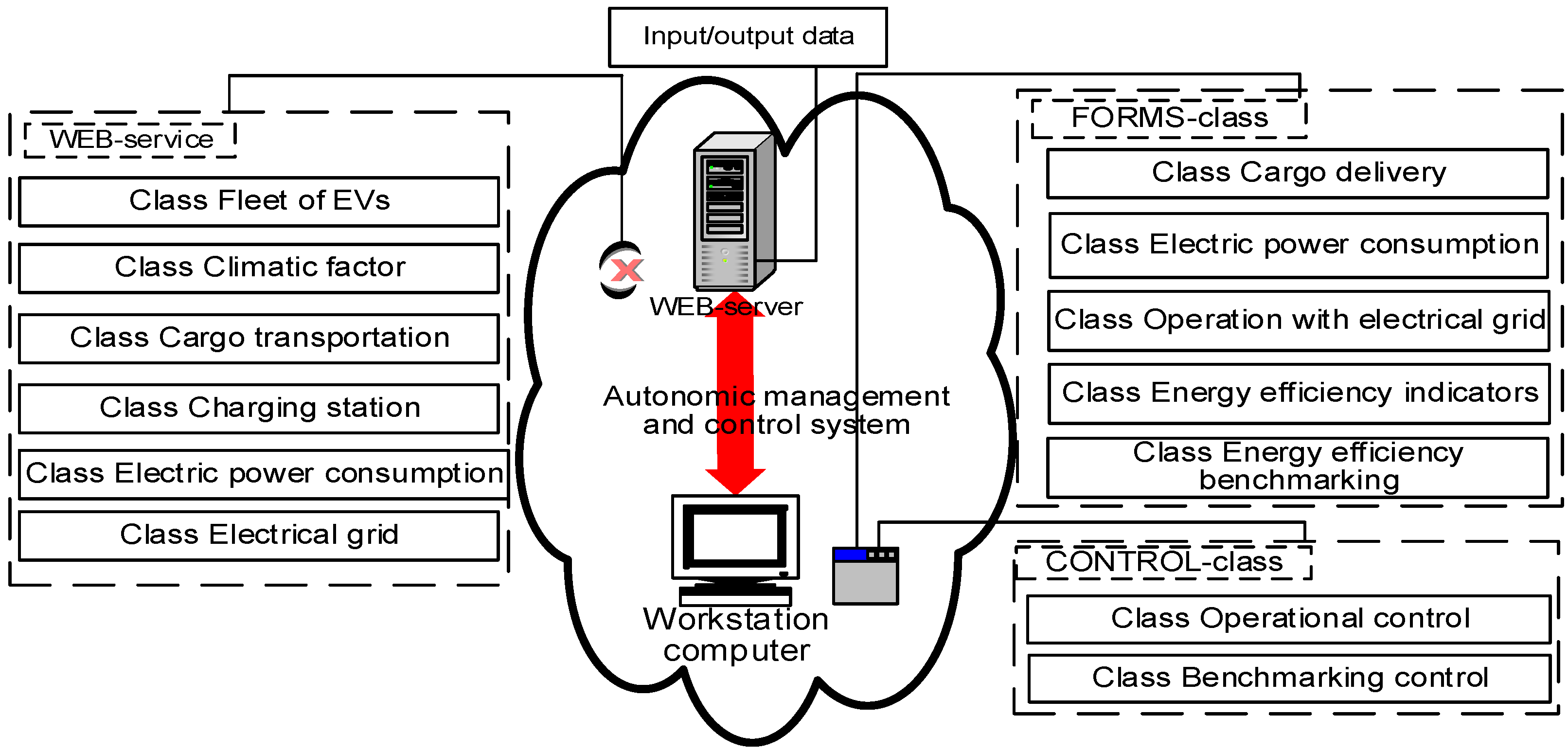

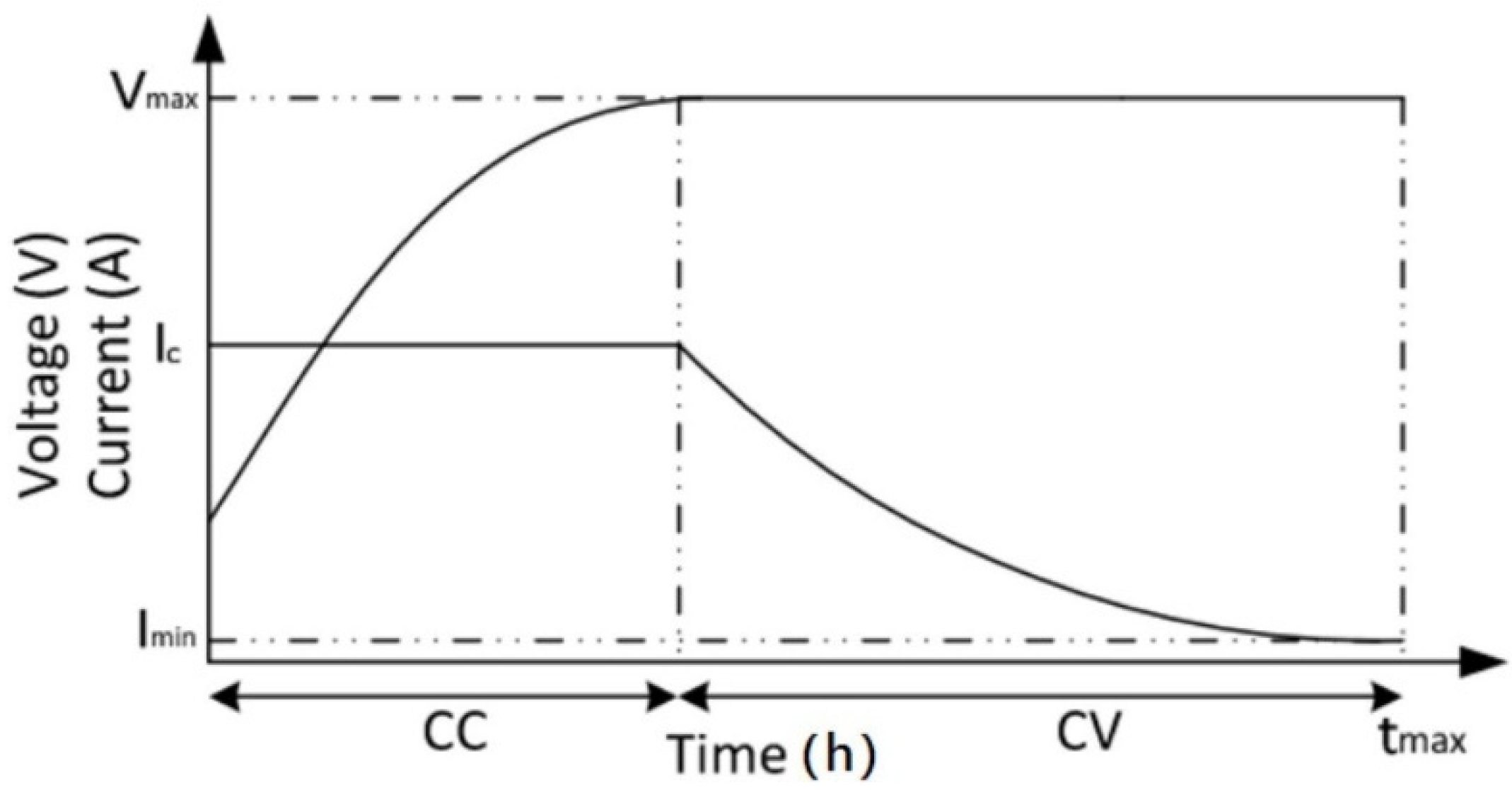

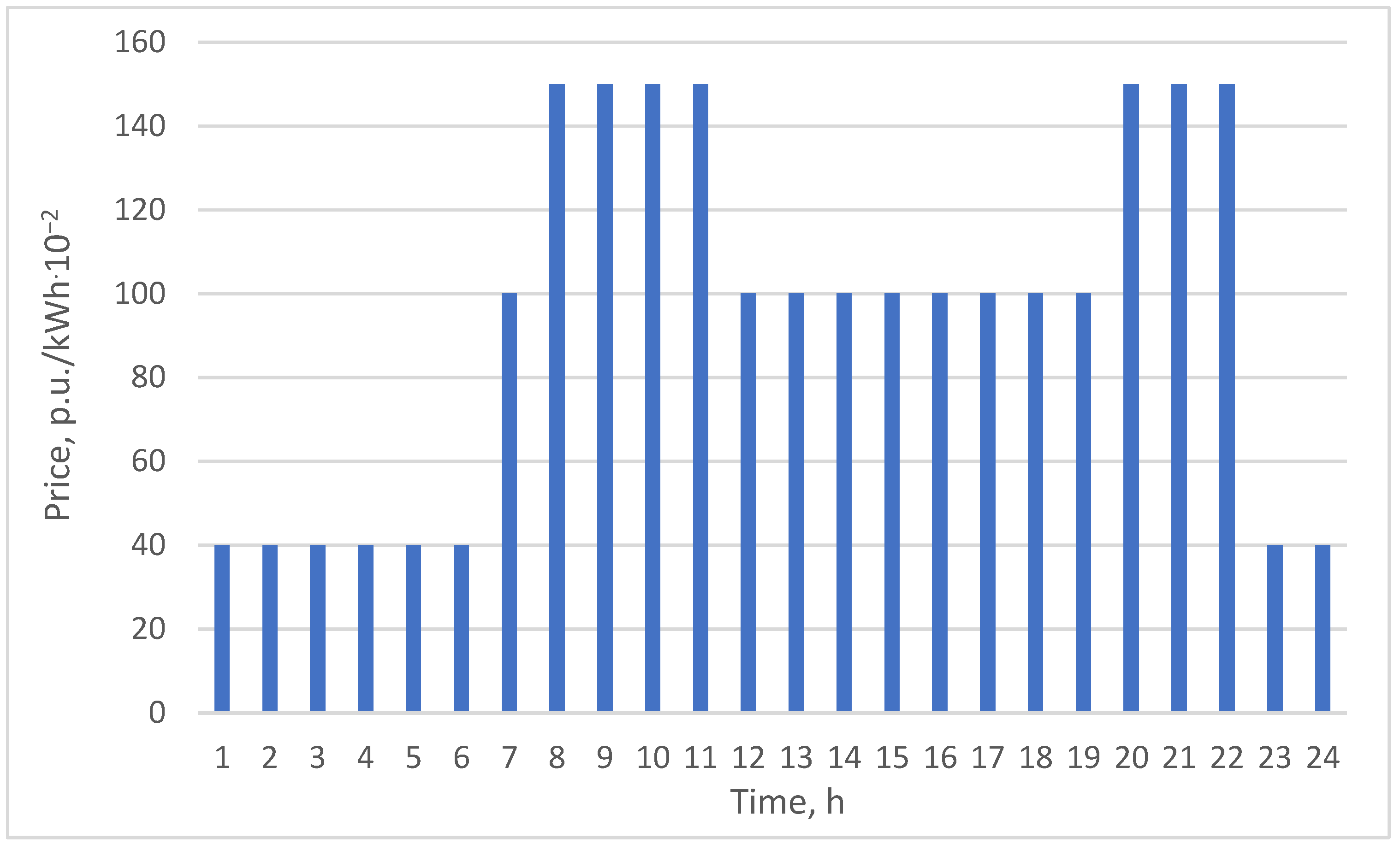
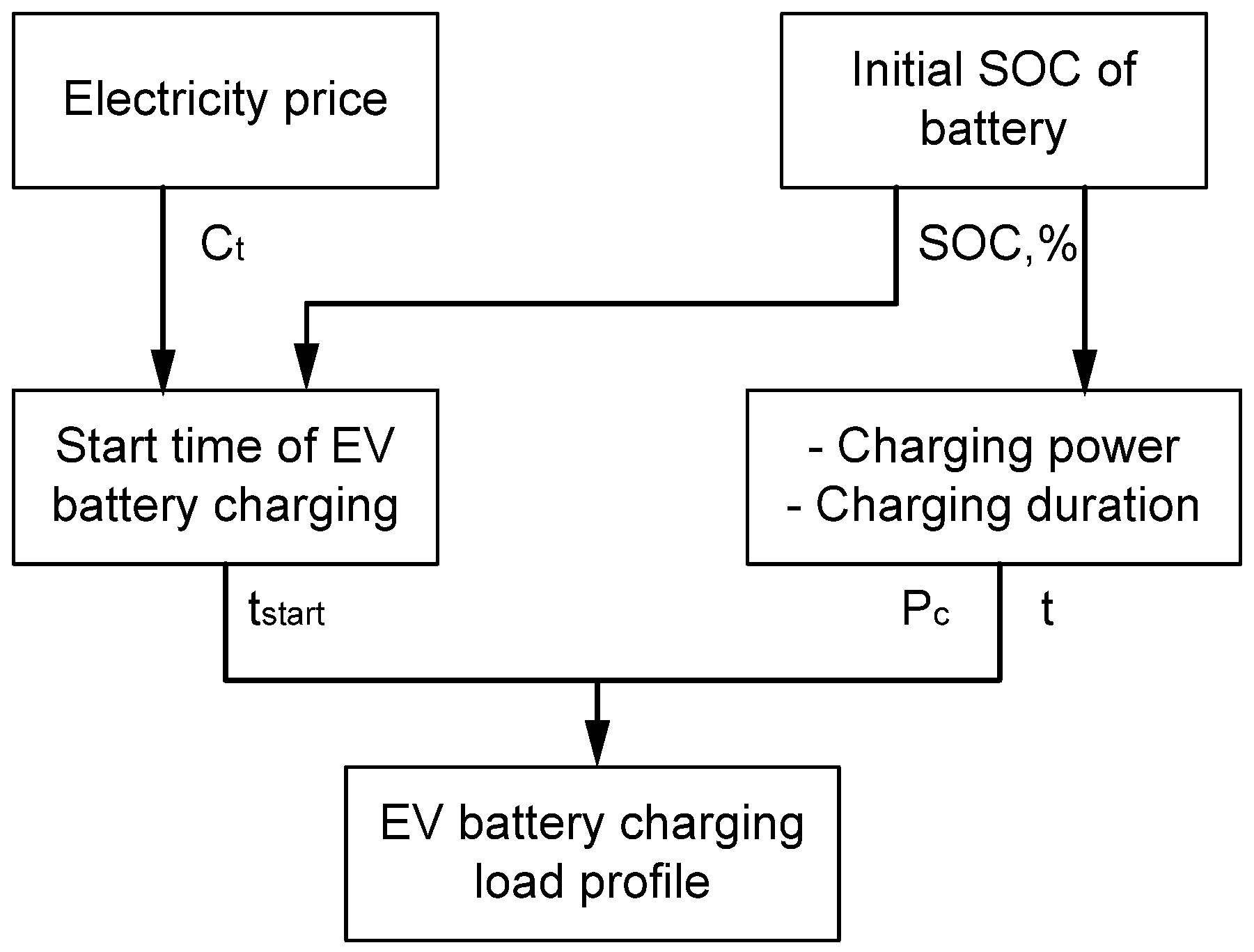

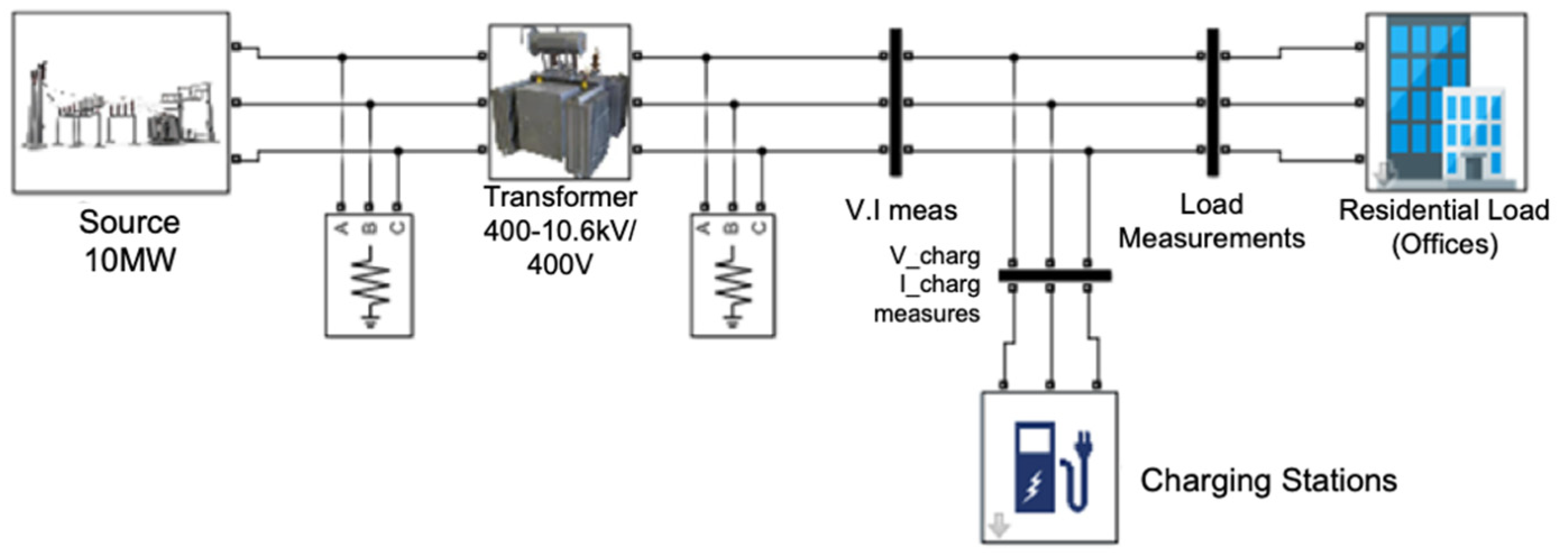

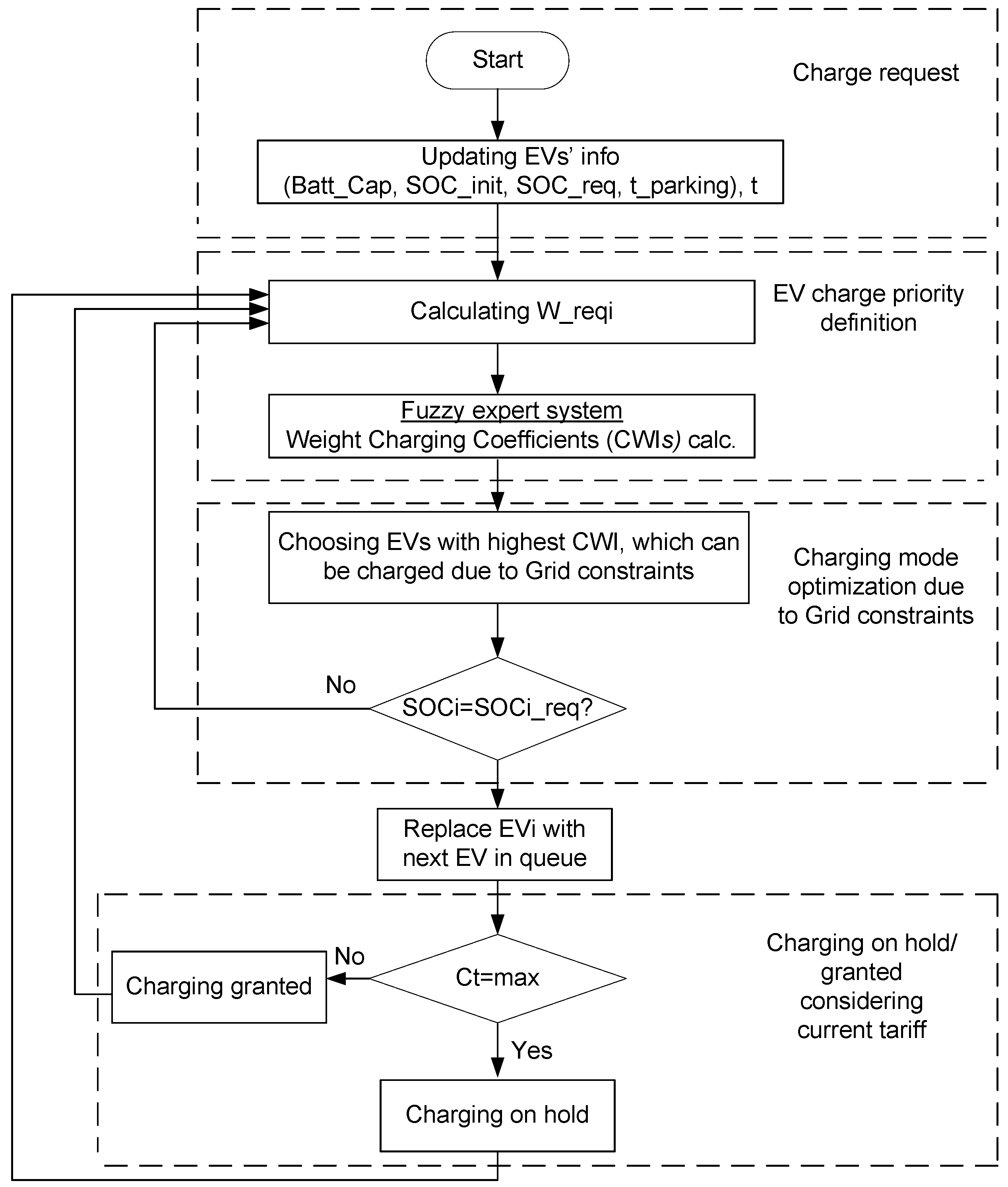
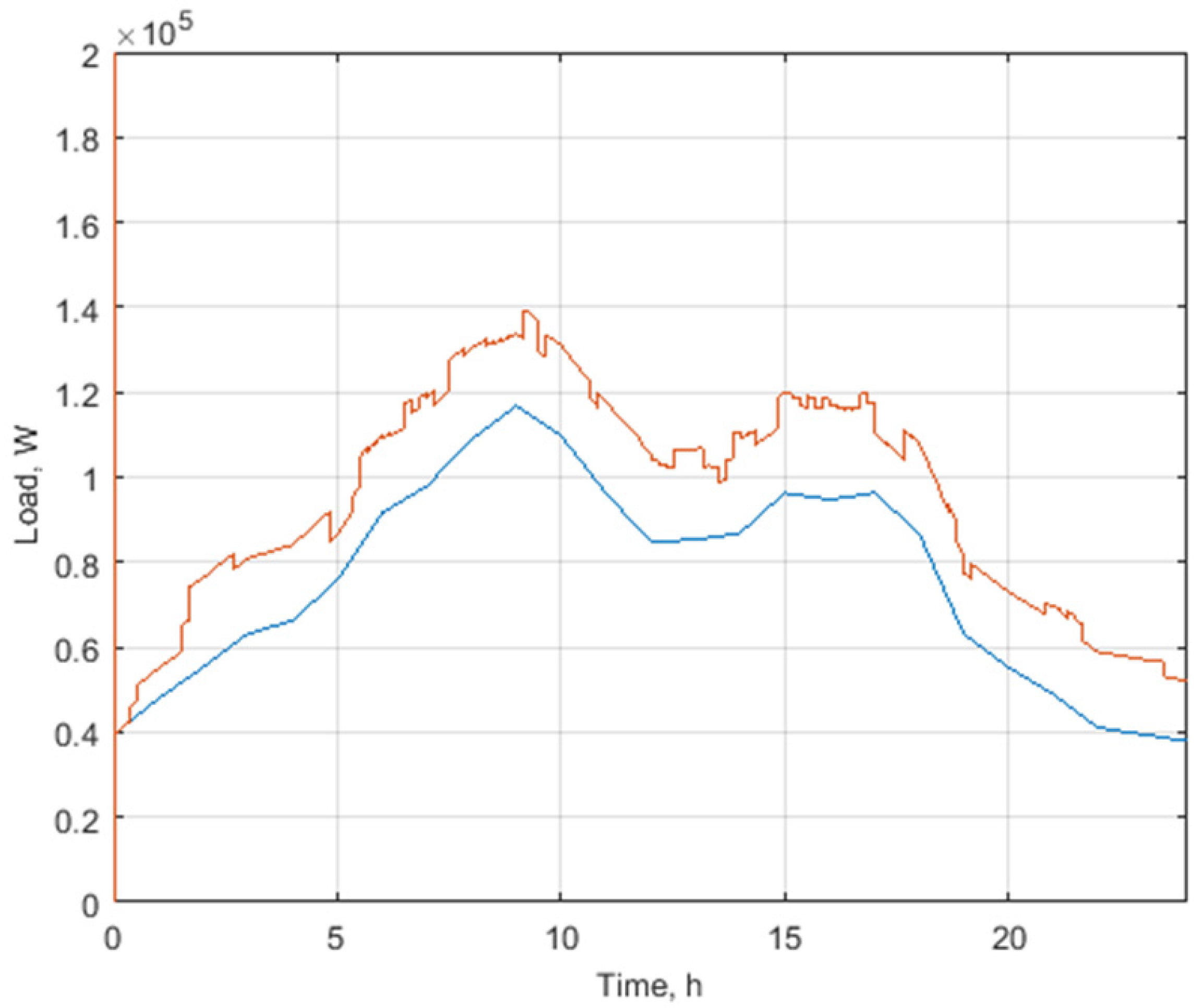
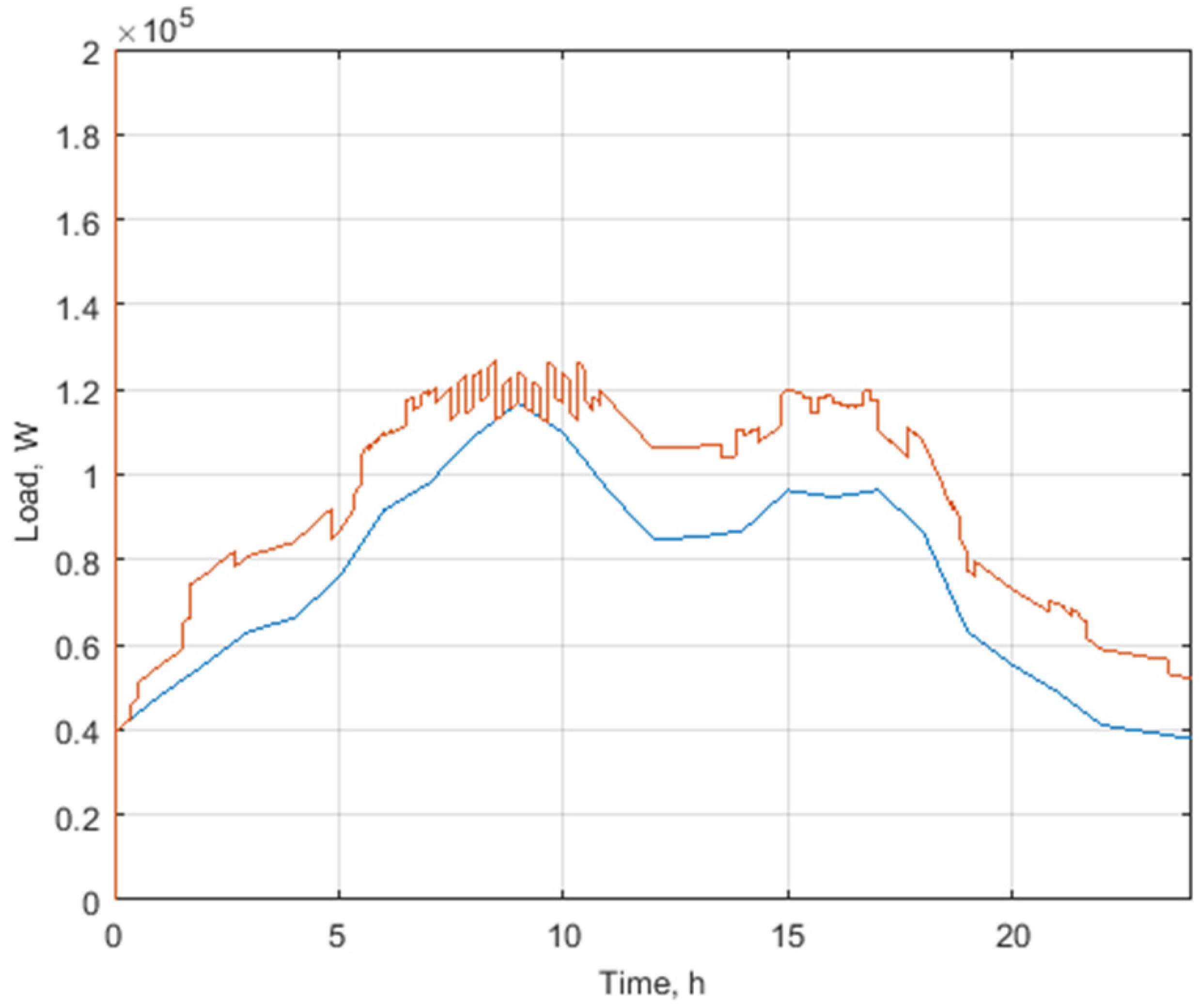

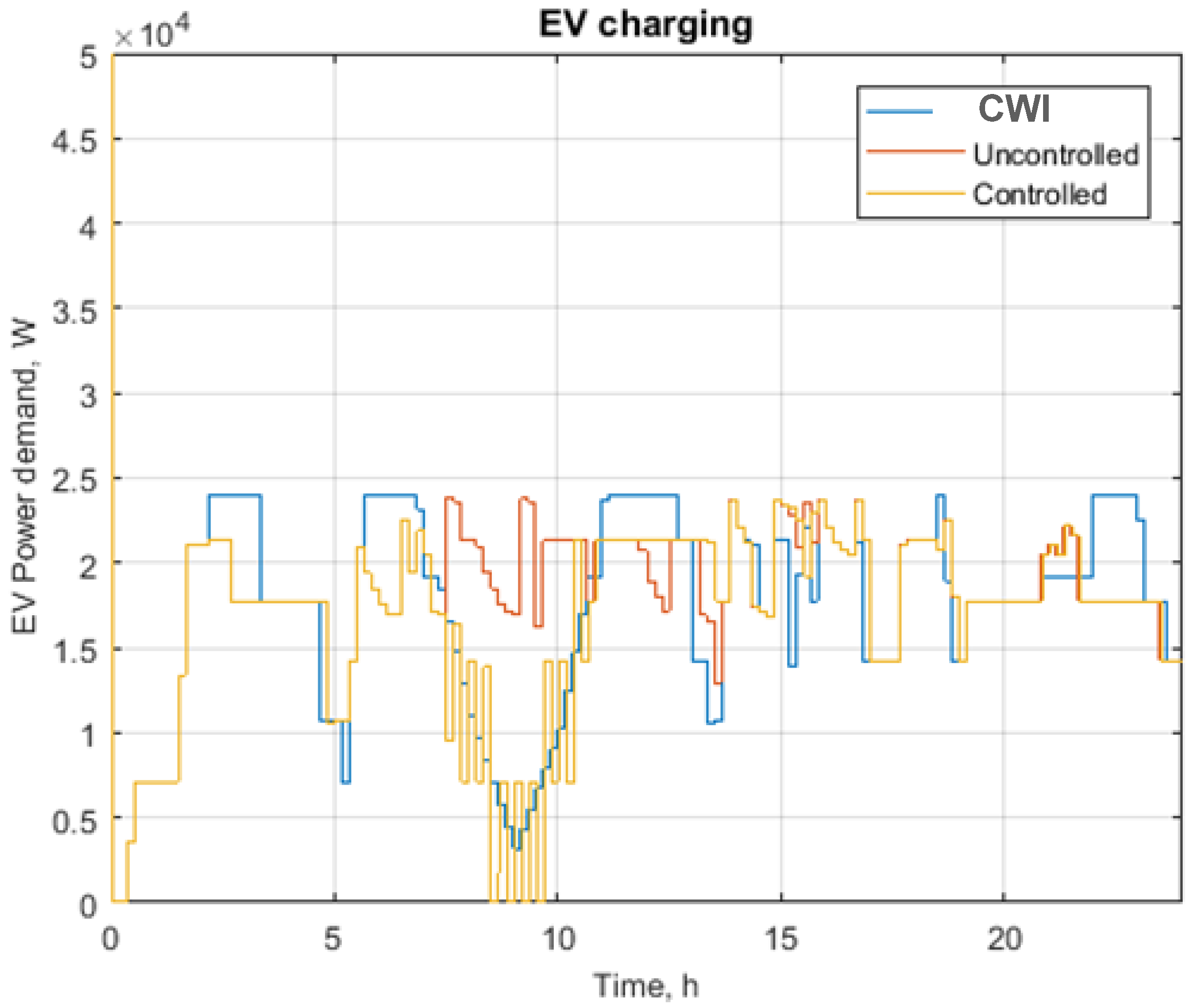
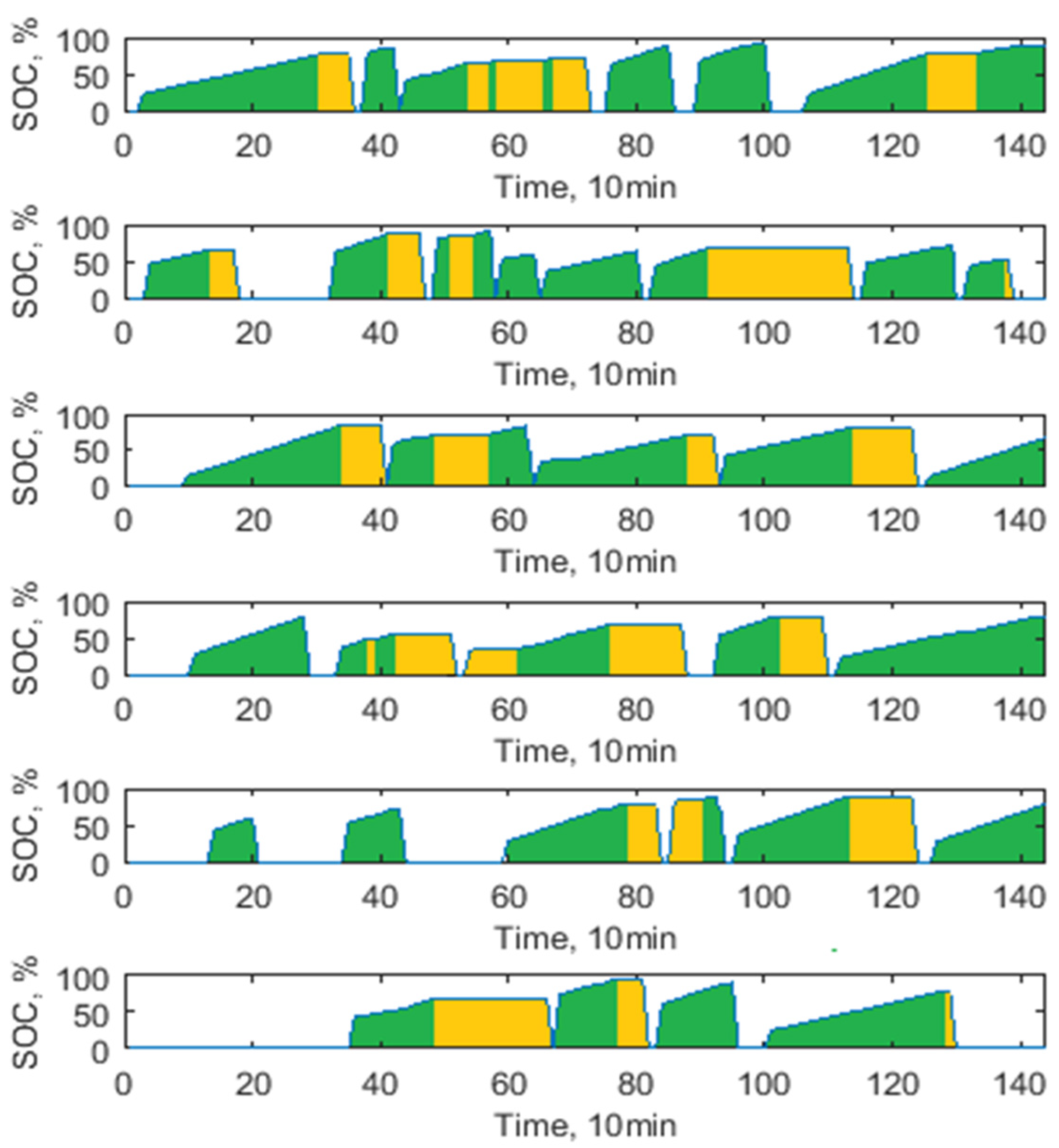
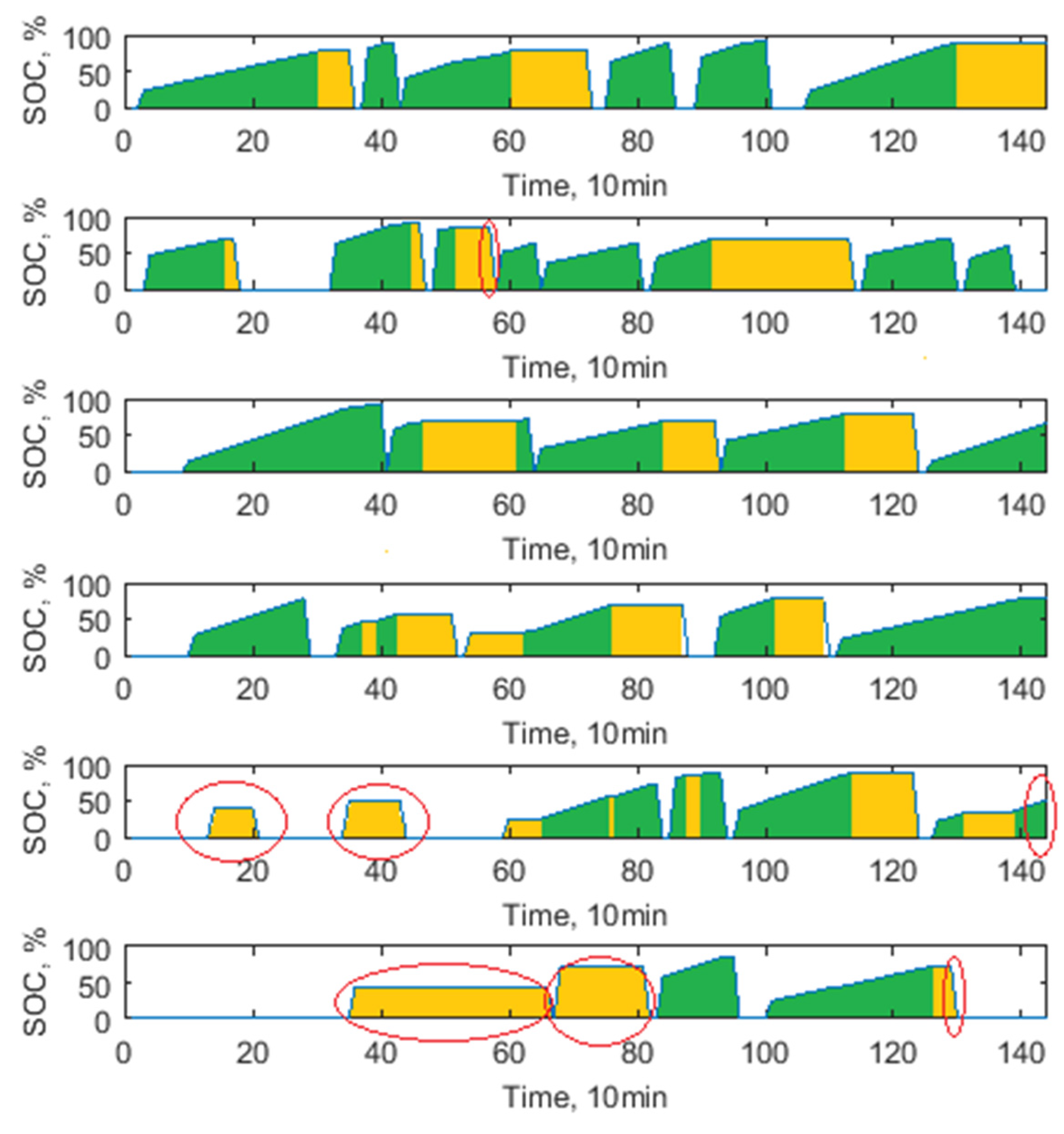
| Electrical Properties | Value |
|---|---|
| Power, Pnom | 2 kW |
| Rated capacity, Qn | 40 Ah |
| Nominal Voltage, Un | 51.2 V |
| Charging Voltage, Uc | 58.4 V |
| Max discharging Voltage, Ud | 44.8 V |
| Average charging current (0.5 C), Ic | 20 A |
| Standard Charging Current (0.3–1.0 C), Ij | 12–40 A |
| Electrical Properties | Value |
|---|---|
| AC Input | |
| Voltage, V | 180–240 |
| Current, A | 7 |
| DC Output | |
| Voltage, V | 58.4 |
| Current, A | 15 |
Publisher’s Note: MDPI stays neutral with regard to jurisdictional claims in published maps and institutional affiliations. |
© 2022 by the authors. Licensee MDPI, Basel, Switzerland. This article is an open access article distributed under the terms and conditions of the Creative Commons Attribution (CC BY) license (https://creativecommons.org/licenses/by/4.0/).
Share and Cite
Davydenko, L.; Davydenko, N.; Bosak, A.; Bosak, A.; Deja, A.; Dzhuguryan, T. Smart Sustainable Freight Transport for a City Multi-Floor Manufacturing Cluster: A Framework of the Energy Efficiency Monitoring of Electric Vehicle Fleet Charging. Energies 2022, 15, 3780. https://doi.org/10.3390/en15103780
Davydenko L, Davydenko N, Bosak A, Bosak A, Deja A, Dzhuguryan T. Smart Sustainable Freight Transport for a City Multi-Floor Manufacturing Cluster: A Framework of the Energy Efficiency Monitoring of Electric Vehicle Fleet Charging. Energies. 2022; 15(10):3780. https://doi.org/10.3390/en15103780
Chicago/Turabian StyleDavydenko, Liudmyla, Nina Davydenko, Andrii Bosak, Alla Bosak, Agnieszka Deja, and Tygran Dzhuguryan. 2022. "Smart Sustainable Freight Transport for a City Multi-Floor Manufacturing Cluster: A Framework of the Energy Efficiency Monitoring of Electric Vehicle Fleet Charging" Energies 15, no. 10: 3780. https://doi.org/10.3390/en15103780
APA StyleDavydenko, L., Davydenko, N., Bosak, A., Bosak, A., Deja, A., & Dzhuguryan, T. (2022). Smart Sustainable Freight Transport for a City Multi-Floor Manufacturing Cluster: A Framework of the Energy Efficiency Monitoring of Electric Vehicle Fleet Charging. Energies, 15(10), 3780. https://doi.org/10.3390/en15103780








